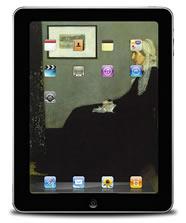Art and Technology
Everyone has heard the old adage, “The world’s oldest profession. ” But it usually isn’t associated with art or technology.
The First Sofa Size Painting
There is significant archeological evidence that art was practiced by our cave-dwelling ancestors, who were driven to capture their daily experiences by rendering scenes on the walls of their dwellings. The first “sofa-size” paintings started here, and who can say that it wasn’t as much decoration as documentation?
The focus of this article is not about the origins of art. It is about the intrinsic dependencies of art and technology, from that first mark made by man through to the digital world we live in today. When the first cave dweller was inspired to render the memory of his hunt on a rock wall, he had to develop a technology that would allow him to accomplish that.
Just Sayin’
I’m not an anthropologist and have no credentials to support this statement, but I think that the concept of leaving a mark was all around him in his daily life — bird droppings on a tree, blood from a fresh kill spread across the ground, the impression of a wet leaf left on a rock. There must have been a number of ways that it was first attempted as a human expression, but regardless of how it happened, a tool was used. Technology.
From that moment on, the technology evolved in response to the evolving progress of our need to express ourselves. As man’s mind became more conceptual, his expression became richer and more subtle. So did his tools. A constant forward development, one propelled by the other.
Left Brain, Right Brain
I hear you. “What about plain ol' technology? What about hunting tools, cooking tools, metal weapons, machines, computers, cars, airplanes, robots...” They all were designed first, or some conceptual design was involved on the fly. Just as art needed technology to come into being, technology needed art to come into being. The earliest toolmaker unwittingly began exercising those parts of the brain that we now depend on to decide what is beautiful and what is ugly — at least in the eyes of the beholder.
So what has this to do with Internet marketing and websites (the reason you landed on this site I presume)? It is because to understand the root of something is to understand its core purpose. In today’s world it is easy to take things at face value because there is no time to contemplate every object and phenomena that crosses our path.
We need our “tools” to get through the day. We drive to work talking on our cell phones, we arrive and boot up or log on on to our computers, and use any number of apps or websites to get our work done, so we can drive home, talking on our cell phone, arriving to switch on the television or computer, etc.
Did you miss it?
Yes, the computers, the apps, the websites, the smartphones, the television — art and technology. Artists, designers, programmers, engineers, manufacturers, all working in concert together to bring you visually exciting tools that are fun to use. I don’t know about you, but I’ve worked with programmers who disregarded the need for UI (user interface) design, allowing their framework to “shine” on its own. And subsequently I’ve worked with the clients for whom the work was produced, and after taking one look at the UI said “I can’t use that.” We’ve all been victims of bad interface design, and it drives our decision to use or not to use.
Draw This Mastadon
User interface design (UI) is founded on basic compositional principles that are almost as ancient as our original ancestors. Good designers exercise similar concepts that great artists invoke when determining what will make their masterpiece pleasing to the beholder. Yes, there are systems and formulas available that someone with the right drive might use to generate a decent user interface for a website or smartphone app, but here we could use the old adage, “You get what you pay for.”
The good designer assesses the needs first. “Ogg — draw mastadon on wall — in red.”
From this objective they begin a process that is difficult, if not impossible for most people to comprehend. Ok, I’ll try.
At a speed faster than is knowable by humans, probably even outside our perception of time as a thing, every aspect related to the design is tested and vetted for emotional pleasure and the winners stick on top. That is just the start. Then a subtle knowing of how it should all be composed to provide an optimal, pleasing experience begins to be expressed in the designers preferred medium.
On numerous occasions I’ve seen a design or painting that accomplishes a high level of success as it relates to academic understanding. A person with this academic knowledge might ask the artist or designer, sometimes self-righteously, how they came to the particular successful solution now in front of them. From the best designers and artists comes this answer: “I’m not sure” or “I couldn’t tell you.” This remark is usually incorrectly interpreted as the artist having no idea what they’re doing.
I submit to you that this is in fact a sure sign that the artist functions on that subtle level of understanding that has given us the most wonderful paintings, sculptures, cinema, television, websites, and apps, and that makes the drudgery of our life a bit more beautiful.
Slow down and take a look.
MONTHLY MARKETING INSIGHTS.
Get thought-provoking and actionable insights to improve how your firm makes a connection with your customers.





LEAVE A COMMENT